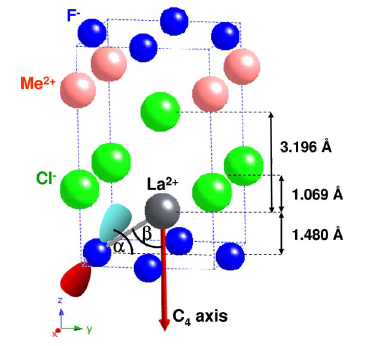-
Anomalous superhyperfine tensor observed in BaFCl doped with the 5d1 ion La2+: Role of 5d-4f hybridization
J.M. Garcia-Lastra, H. Bill, M.T. Barriuso, J.A. Aramburu and M. Moreno
Physical Review B, 75 (15) (2007), p155118


DOI:10.1103/PhysRevB.75.155118 | unige:3598 | Abstract | Article PDF | Article PS (gzipped)

The fluorine superhyperfine (shf) tensor measured in aFCl:La2+has been found to be practically isotropic, a result which is certainly anomalous when compared to that for em>d9centers with one unpaired electron in a em>x2ây2orbital. This puzzling fact has been explored by means of density functional calculations. Obtained results confirm that in the em>C4vequilibrium geometry the unpaired electron lies in a em>b1(â¼x2ây2)orbital which overlaps with the sorbitals of four âligands. For explaining the origin of the near isotropy, which is well reproduced by the present calculations, the simple em>D4hand i>C4vaF42â F42â and gF42âcenters have also been investigated. Although the obtained results stress the high dependence of the isotropic shf constant i>Ason the metal-ligand distance i>R a near isotropy of the shf tensor is only reached for aF42â(but not for F42â under i>C4vsymmetry which corresponds to the actual symmetry of the a2+center in the BaFCl lattice. The origin of this peculiar situation is shown to come from the mixing between dand forbitals of a2+allowed in i>C4vsymmetry thus stressing the role played by forbitals in bonding properties. Writing i>As=CRânsit is shown that for the i>D4haF42âand F42âcomplexes the exponent i>nsis around 20, while it is only equal to 4 for gF42â This huge difference is shown to stem from the quite distinct slope of the radial i>dwave function at the equilibrium distance for the two i>d1centers and the i>d9gF42âunit. Finally, the present calculations strongly support that the intense band peaked at 7 Â 890 Â cmâ1recorded in the optical absorption spectrum of aFCl:La2+is indeed a dâ4ftransition.
